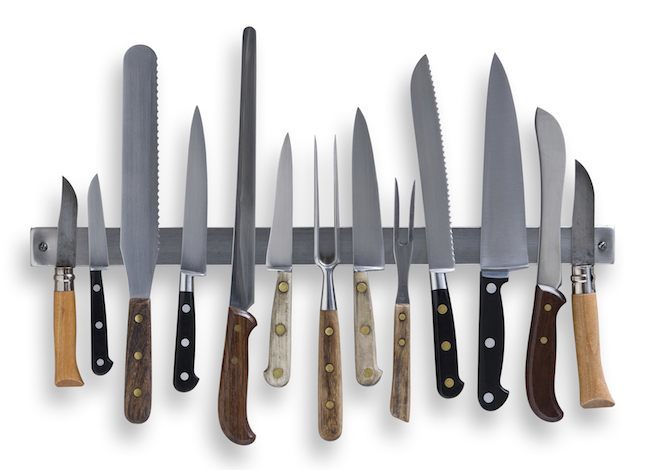Your Chefs Deserve the Best Knives; Here are 6 Things to Look at When Choosing the Best Tools

Selecting which knife to work with is a huge step for any chef and your chefs deserve the best equipment. While choosing a knife is based mostly on personal preference and chefs will have their own knives, a kitchen should also provide them. Most commonly used professional knives are being produced in either Germany or Japan, and while there are too many to go over in a brief article, we’d like to present you with a checklist of elements to look at, in order to ensure your Chef has everything they need to perform optimally.
1. Build
Your knife should be strong. Look at how tightly the blade is attached to the handle — is there any risk of the two separating? Knives are likely to bend or break at points where they are welded together and ideally a knife should be made of one long piece of steel.
2. Handle
A poorly carved handle can make hours in the kitchen take a nasty toll on your hand. Questions you can ask are: Is the handle easy and comfortable to hold? How durable is the wood? Quite simply, how good and natural does it feel?
3. Balance
Are the handle and blade balanced well? A knife that isn’t well balanced, one that teeters as you cut or that feels heavier at the front of the blade or the handle, will be harder to work with. A simple way to test is to lay it horizontally across your finger and see which way it teeters…be careful though, as lighter knives will likely immediately fall off.
4. Blade
Harder steel stays sharp longer, but is more difficult to sharpen. Softer steel needs to be sharpened more frequently, but is easier to sharper. Depending on usage and the kind of steel, seek out a specialist to determine how frequently you need to sharpen.
5. Weight
Do you prefer a heavier knife or a lighter one? Chefs usually have a preference for one or the other, often determined by the kind of cutting they do.
6. Size
Smaller knives (around 6-inches or less), are easier to work with and allow quicker movements, but are difficult to cut large items with, while 10-inch blades can obviously cut more volume. You need to understand how many of each kind of knife your kitchen requires.
Japanese Knives
Known for their flat cutting edges, those using traditional Japanese knives will be unable to cut using rocking chopping motions that Western cooks often employ. They may be somewhat more difficult to manoeuvre for those without experience; however, once you get the hang of it, these style of knives are excellent at slicing, chopping, and mincing. Keep in mind that they are not necessarily ideal for cutting harder items such as squashes.
Western Knives
Generally quite versatile, Western knives have sharp tips and are heavier than Japanese knives. They are best for cutting larger, harder items such as bones, and are usually made of softer steel, meaning (like we stated earlier) that they require more frequent sharpening.
Caring for your knives
To keep your knives working for you, the following will ensure they stay in tip-top shape:
-
One piece of advice heard frequently is rubbing both sides of a stainless steel or carbon-based blade with a lemon to remove signs of oxidizing.
-
Knives should never be run through a dishwasher as this can dull the blade or potentially expose it to bacteria growing within the dishwasher.
-
Keeping protectors on your knives is the best and easiest way to keep them functional as long as possible.
-
Knives should be cleaned with bleach water at a 1:100 bleach to water ratio, and you should never be able to smell the bleach. Testing strips should always be kept nearby to ensure that any sanitation solution you’re using is kept at a safe level.
-
Finally, don’t use the knife on stone, glass, steel or ceramic cutting boards!
Understanding your personal preferences in terms of these characteristics, will help you identify and find your perfect knife. Every Chef has their preference so testing out several knives is recommended prior to investing too much into a particular knife. Pro tip: The first time that you’re buying a knife, make sure that you try it out and don’t buy online. And lastly, any salespeople you interact with should be able to explain the different elements and characteristics of a knife rather than just trying to convince you that a particular knife will be best for your needs.

News you care about. Tips you can use.
Everything your business needs to grow, delivered straight to your inbox.


